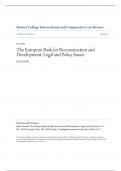Boston College International and Comparative Law Review
Volume 18 | Issue 2 Article 3
8-1-1995
The European Bank for Reconstruction and
Development: Legal and Policy Issues
John Linarelli
Recommended Citation
John Linarelli, The European Bank for Reconstruction and Development: Legal and Policy Issues, 18
B.C. Int'l & Comp. L. Rev. 361 (1995), http://lawdigitalcommons.bc.edu/iclr/vol18/iss2/3
This Article is brought to you for free and open access by Digital Commons @ Boston College Law School. It has been accepted for inclusion in
Boston College International and Comparative Law Review by an authorized administrator of Digital Commons @ Boston College Law School. For
more information, please contact emick@bc.edu.
, The European Bank for Reconstruction
and Development: Legal and Policy Issuest
John Linarelli*
INTRODUCTION
On May 29, 1990, in Paris, France, representatives of forty na-
tions, the European Community (EC) and the European Invest-
ment Bank signed the Agreement Establishing the European Bank
for Reconstruction and Development. l The purpose of the Bank is
to promote the development and reconstruction of the countries
of Central and Eastern Europe. 2 The Bank was conceived by Pre-
sident Francois Mitterrand of France and initially proposed by
him in October 1989. Its establishment was agreed upon in only
seven short months. 3 The Agreement came into effect in March
1991 and the Bank began operations in April 1991. 4 It has its head-
t Copyright John Linarelli February 23, 1995.
* Partner, Braverman & Linarelli; President, International Development Consultants, Inc.;
Lecturer, Catholic University of America Columbus School of Law; B.A. 1981 Duquesne
University; J.D. 1985 The American University Washington College of Law. A grateful thank
you to Peter Fox, Partner at Mallesons Stephen Jaques, and Adjunct Professor at the George-
town University Law Center, for his encouragement and guidance.
I Agreement Establishing the European Bank for Reconstruction and Development, May
29, 1990, 29 I.L.M. 1077 (1990) [hereinafter Agreement]. The European Bank for Recon-
struction and Development shall hereinafter be referred to as the "EBRD" or the "Bank."
2 As of April 1994, the Bank operates in the following countries: Albania, Armenia, Azer-
baijan, Belarus, Bulgaria, Croatia, Czech Republic, Estonia, Former Yugoslav Republic of
Macedonia, Georgia, Hungary, Kazakhstan, Kyrgyzstan, Latvia, Lithuania, Moldova, Poland,
Romania, Russian Federation, Slovak Republic, Slovenia, Tajikistan, Turkmenistan, Ukraine
and Uzbekistan. EUROPEAN BANK FOR RECONSTRUCTION AND DEVELOPMENT, FINANCING WITH
THE EBRD 2 (1994) [hereinafter FINANCING WITH THE EBRD].
3 See Mark Easton & Kathryn Rorer, Recent Developments-The European Bank for Reconstruc-
tion and Development, 32 HARV. INT'L LJ. 527, 527 (1991); see also Steven Weber, Origins of
the European Bank for Reconstruction and Development, 48 INT'L ORG. 1,9-31 (1994) (provid-
ing detailed history of the development of the Agreement establishing the Bank).
4 Easton & Rorer, supra note 3, at 527; EUROPEAN BANK FOR RECONSTRUCTION AND DEVEL-
OPMENT, 1991 ANNUAL REpORT 9 (1992) (,The idea of the Bank was first conceived in
October 1989, before the Berlin Wall came down; it was inaugurated in April 1991 before the
Moscow coup; and, in a matter of months, it has become fully operational. It has a staff of
361
,362 BOSTON COLLEGE INTERNATIONAL & COMPARATIVE LAw REVIEW [Vol. XVIII, No.2
quarters in London, although both of its presidents have been
French. 5
The formation of the Bank has been hailed as remarkable. It has
been described as "the first post cold war institution,"6 and the "first
institution of the new world order."7 The majority of the Bank's
shareholders are the states that comprise the European Union (EU),
although the EC itself and the European Investment Bank are also
shareholders.8 The United States is the largest single shareholder in
the Bank, and played an influential role in crafting key provisions
of the Articles of Agreement for the Bank. 9
The Bank is European in character, with an American influence. 1o
It was formed at a time when there was an absence of one or a few
dominant nation-states. As explained by one scholar of international
relations:
EBRD extends the scale and scope of cooperation among
the Western powers to encompass a new geographic re-
gion. It is doing this during a period of rapid international
change and in the absence of hegemonic concentration of
power; and it is doing this according to a set of ideas and
standards of legitimacy that derive principally from a net-
work of international institutions in Europe. ll
The Bank is a unique multilateral development institution. Its
charter is based on political conditionality, a concept forbidden to
the World Bank. 12 The very first article of the Articles of Agreement
close to 400 from almost all of its member countries."). The Bank got off to a slow start, in
that its loan activities initially were relatively low. The Bank attributed this to the restrictions
in its Articles of Agreement and the lack of appropriate private sector projects in Central and
Eastern Europe. See Andre Newburg, Eastern Europe and the European Bank for Reconstruction
and Development, 28 INT'L LAW. 433, 437 (1994); see infra notes 26-50 and accompanying text.
5 Easton & Rorer, supra note 3, at 527.
6Id. (quoting THE TIMES (London), Oct. 10, 1990, at 31, col. 1).
7 PAUL A. MENKVELD, ORIGIN AND ROLE OF THE EUROPEAN BANK FOR RECONSTRUCTION AND
DEVELOPMENT 96 (1991).
8 See infra note 50 and accompanying text.
9 See infra note 50 and accompanying text.
10 See EUROPEAN BANK FOR RECONSTRUCTION AND DEVELOPMENT, Chairman's Report on the
Agreement Establishing the European Bank for Reconstruction and Development, in BASIC Docu-
MENTS OF THE EUROPEAN BANK FOR RECONSTRUCTION AND DEVELOPMENT 53, 55, art. 4 (1991)
[hereinafter Explanatory Notes]. "The essential European character of the Bank lent itself to
the denomination of its original authorized capital stock in the European Currency Unit, the
ECU." Id.
II Weber, supra note 3, at 2.
12 The official name of the World Bank is the International Bank for Reconstruction and
Development. The World Bank has several affiliates, the International Development Associa-
, 1995] EUROPEAN BANK 363
of the Bank states that the purpose of the EBRD "shall be to foster
the transition towards open market oriented economies and to pro-
mote private and entrepreneurial initiative in the Central and East-
ern European countries committed to and applying the principles
of multiparty democracy, pluralism and market economics. "13 More-
over, the Preamble of the Agreement provides, in pertinent part,
that the contracting parties are "[c]ommitted to the fundamental
principles of multiparty democracy, the rule of law, respect for
human rights and market economics" and welcome "the intent of
the Central and Eastern European countries to further the practical
implementation of multiparty democracy, strengthening democratic
institutions, the rule of law and respect for human rights and their
willingness to implement reforms in order to evolve towards market-
oriented economies."14 The overt political nature of the EBRD's
mandate is a radical departure, a never-before-used approach in
multilateral development financing institutions.
The Bank's political mandate illustrates its post Cold War charac-
ter. More fundamentally, the Bank can be viewed as a significant
foreign policy tool of its powerful Western shareholders. 1s An insti-
tution with such a political mandate, operating in critical and sen-
sitive regions in Central and Eastern Europe, necessarily implicates
foreign policy considerations. This is true for the EU and its Member
States, which share geographical proximity to the countries of Cen-
tral and Eastern Europe, as well as for the United States, the last
remaining superpower. 16
tion, the International Finance Corporation and the Multilateral InvesUnent Guarantee
Agency. The World Bank will be hereinafter referred to as either the 'World Bank" or the
"IBRD." The Articles of Agreement for the World Bank provide that "[t]he Bank shall not
interfere in the political affairs of any member." Articles of Agreement of the International
Bank for Reconstruction and Development, Dec. 27, 1945, art. II, 2 U.N.T.S. 134, quoted in
Jonathan Cahn, Challenging the New Imperial Authority: The World Bank and the Democratiza-
tion of Development, 6 HARV. HUM. RTs.J. 159, 163 (1993).
13 Agreement, supra note 1, art. 1.
14 Agreement, supra note 1, pmbl.
15 Dr. Edward A. Hewitt, of the Brookings Institution, has testified before the U.S. Congress
that the EBRD "is a good investment in democracy and in our national security, probably a
far better invesUnent than yet another weapons system or more spending on existing weapons
systems." European Bank for Reconstruction and Development; Hearings Before the Subcomm. on
International Economic Policy, Trade, Oceans and Environment of the Senate Comm. on Foreign
Relations, lOlst Cong., 2d Sess. 26-27 (1990) (statement of Dr. Edward A. Hewett, Senior
Fellow, Brookings Institution).
16 Professor Eric Stein explains the role of democracy in foreign relations as follows:
United States Secretary of State George Marshall told the General Assembly of the
United Nations in 1948 that "[g]overnments which systematically disregarded the
rights of their own people were not likely to respect the rights of other nations and





